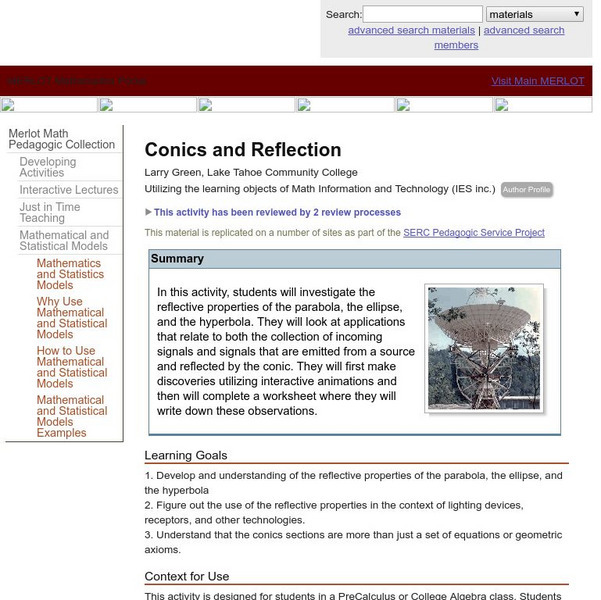Hi, what do you want to do?
Curated OER
Discovering Conic Sections in the Motion of Heavenly Bodies
Math scholars study conics and how they are used today. For this mathematical lesson, pupils construct and slice cones after viewing a demonstration.
West Contra Costa Unified School District
Conics Introduction and Parabolas
Where did conic sections get their name? The equation and graph of a parabola are developed from the definition of the conic section. Teacher examples on graphing the equation and writing an equation from the graph round out the plan.
Curated OER
Introduction to Conic Sections
Learners slice cones and identify the different conics formed. They then derive the formula to solve problems involving cones. Pull out the TI calculators to visualize the slicing and the different parts and properties created.
Curated OER
Conic Sections
Students, while using a graphing calculator, graph systems of conic sections as well as identify their solutions. They complete various word problems dealing with conic sections with their calculators. In addition, students sketch graphs...
West Contra Costa Unified School District
Standard Form of Conics
Looking for a complete go-to guide for the standard form of conics? This five-page packet does a nice job of connecting conics to prior knowledge of functions and transformations. Adapt the resource as Algebra II lesson plan...
Curated OER
Conics in Geometry
High schoolers analyze characteristics and properties of two and three-dimensional shapes in this geometry instructional activity. They follow detailed directions to use the Cabri Geometry II Application on their TI-89 calculator to...
Curated OER
Hyperbolas: Sketching from the Equation
In this algebra worksheet, students sketch graphs of hyperbolas after solving equations to standard form and interpreting the center, vertices, foci, axis, asymptotes, and eccentricity from the equation. There are 58 questions.
Curated OER
As The World Curves
Learners partisipate in a web scavenger hunt on an introductory lesson for conic sections. They become familiar with general forms of the equations, what they look like, and how they are used in the real-world.
Shodor Education Foundation
Cross Sections
Use this activity on cross-sections of three-dimensional shapes in your math class to work on algebra or geometry Common Core standards. The lesson includes a list of relevent terminology, and a step-by-step process to illustrate the...
Curated OER
Conic Sections and Locii
Students differentiate between ellipse and hyperbola. In this algebra lesson, students graph and solve elliptical equations. They use the cabri program to create the different conics and move them around.
Curated OER
Faster speed-Shorter Time
Students calculate the inverse variation, and speed given the formulas. In this algebra lesson, students investigate properties of conics, focusing on the hyperbola. They identify the distance between the directrix and other parts...
Curated OER
Confocal Conics
Students describe conic sections from an equation or graph. They examine a family of conics that share a vertex, describe their relationship and write an equation. Students interpret the relationship between conic sections and write...
Curated OER
Graphing at all Levels: It's a Beautiful Thing!
Mixing math and art is done in this lesson by applying graphing knowledge to create a unique piece of art. This lesson varies acording to the graphing knowledge of the artist. First, learners identify and review various types of graphing...
Curated OER
Translation and Rotation of Axes
Students rotate axes to eliminate the xy-term and illustrate the dissectible cone as needed. They also discuss the discriminant for the second degree equation in two variables, as well as the translation of axes and rotation of axes....
Alabama Learning Exchange
Ellipse
Students explore the concept of ellipses. In this ellipses lesson, they construct ellipses on their paper and follow directions on a worksheet that allow them to investigate an ellipse in more depth by looking at the major axis, foci, etc.
Curated OER
Kepler and his Laws
High schoolers examine Kepler's Laws. They confirm Kepler's 3rd law by comparing orbital periods and mean distances for all major planets and study conic sections, qualitatively.
Curated OER
Planet Paths: Studying Planetary Orbital Paths
Middle schoolers define and identify planetary orbit, ellipse, parabola, and hyperbola, and simulate Kepler's Second Law. They explore interactive websites demonstrating orbital motion and complete modeling activities.
Curated OER
Slopes and Slope Intercepts
Students identify the slope of an equation using various methods. For this algebra lesson, students graph linear equations and calculate the slopes using the x and y intercept to solve the equations and graph the lines. They use the...
Curated OER
Ellipses (Part 1)
Students work with Ellipses in Algebra II. In this algebra lesson, students solve an equation with a radical expression. They graph ellipses and write an equation for them.
Curated OER
Circles
Students graph circles. For this graphing lesson students write equations for circles. Students solve equations for circles and graph the results.
Curated OER
Kepler And His Laws
Students engage in an overview of the story of Tycho Brahe and Johannes Kepler, and of Kepler's laws. Each of Kepler's laws be studied separately in more detail in later lessons. They examine Kepler's 3rd law.
Alabama Learning Exchange
Alex: Conic Sections: Discovering the Degenerates
Through a mixture of online exploration, and teacher instruction, students will discover how the degenerate forms of the conic sections are formed and will be able to identify the degenerate case of each conic section.
Science Education Resource Center at Carleton College
Serc: Conics and Reflection
Students investigate the reflective properties of the parabola, the ellipse, and the hyperbola. They will look at applications that relate to both the collection of incoming signals and signals that are emitted from a source and...
Alabama Learning Exchange
Alex: Conic Sections: Playing With Hyperbolas
Through a mixture of online exploration, and teacher instruction, learners will discover how Hyberbolas are formed and will be able to use the key components (center, vertices and the asymptotes) to generate the equation of a graph.




























